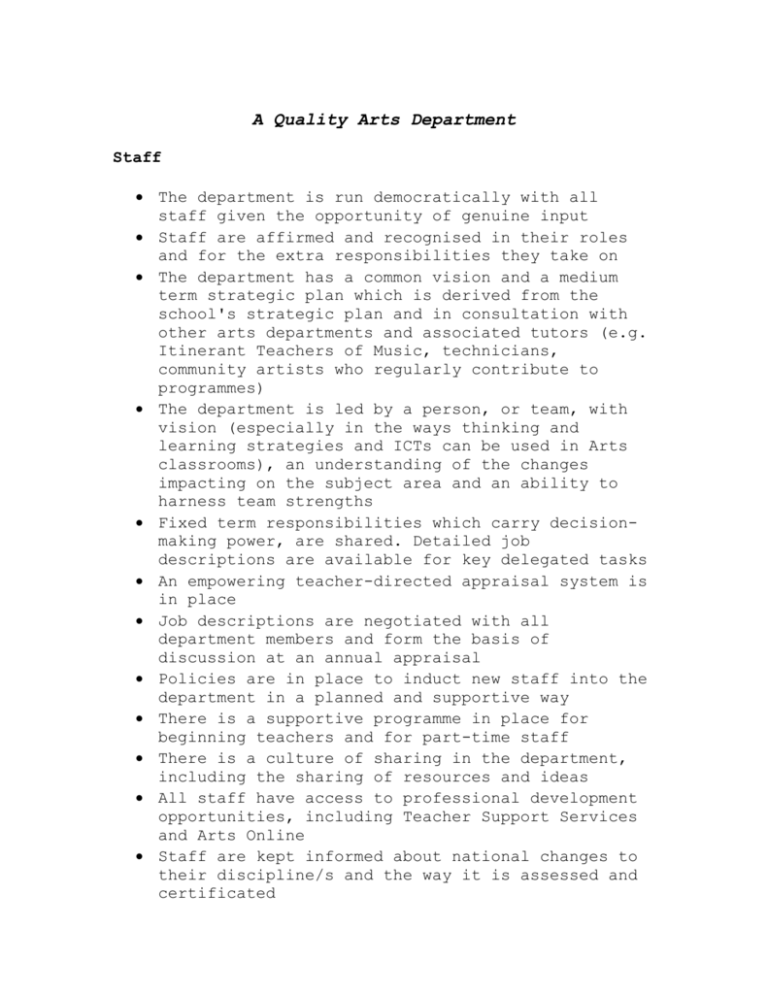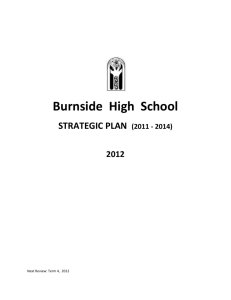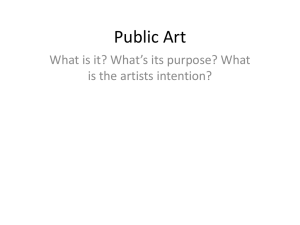A Quality Arts Department - Arts Online
advertisement

A Quality Arts Department Staff The department is run democratically with all staff given the opportunity of genuine input Staff are affirmed and recognised in their roles and for the extra responsibilities they take on The department has a common vision and a medium term strategic plan which is derived from the school's strategic plan and in consultation with other arts departments and associated tutors (e.g. Itinerant Teachers of Music, technicians, community artists who regularly contribute to programmes) The department is led by a person, or team, with vision (especially in the ways thinking and learning strategies and ICTs can be used in Arts classrooms), an understanding of the changes impacting on the subject area and an ability to harness team strengths Fixed term responsibilities which carry decisionmaking power, are shared. Detailed job descriptions are available for key delegated tasks An empowering teacher-directed appraisal system is in place Job descriptions are negotiated with all department members and form the basis of discussion at an annual appraisal Policies are in place to induct new staff into the department in a planned and supportive way There is a supportive programme in place for beginning teachers and for part-time staff There is a culture of sharing in the department, including the sharing of resources and ideas All staff have access to professional development opportunities, including Teacher Support Services and Arts Online Staff are kept informed about national changes to their discipline/s and the way it is assessed and certificated The department belongs to all relevant professional organisations - such as: MENZA, Drama NZ, ANZAAE, DANZ, NZAHTA - and any local arts associations or clusters as appropriate Departmental members are encouraged to play a part in the decision-making processes in the wider school Social occasions and team-building occasions are part of the culture of the department All aspects of the department, including the performance of the HOD, are subject to annual review Staff within the wider school community with a vested interest, for example Learning Support, ESOL, the Librarian, ICT staff, community artists/mentors, ITMS etc are included in the department's discussions around learning All staff are expected to network with colleagues from other schools, including contributing schools, participate in cluster groups, and collaborative professional development opportunities Staff are encouraged to apply and involve themselves in external assessment opportunities such as national moderation and assessment. Students Students are taught and assessed in a variety of ways to recognise different learning styles, interests and abilities, making connections with their prior learning and knowledge Teaching and learning is informed by an evidencebased approach, responding to available student data, such as diagnostic tests, pre-assessments, pastoral information, teacher observation and so on, in order to develop learning programmes that best meet student needs, extending strengths and addressing areas of weakness Teacher practice includes facilitating differentiated learning, embedding arts strategies into daily teaching to raise students' arts literacies, interest, and knowledge about arts practices in New Zealand and around the world, over time and in contemporary contexts, particularly in contexts relating to Aoteaora New Zealand and the Pacific region There is an agreement on those aspects of the curriculum which will be focused on in a particular year to track student achievement At the beginning of all courses, students are provided with information on: - the aims of the course together with its specific objectives - the content of the course and where it fits into their development and the curriculum - course requirements and expectations - assessment and certification information - appeal procedures - policy on missed assessments and reassessment - avenues of assistance - homework policy - work completion requirements - guidelines for success in the subject - resources - record-keeping - use of school facilities outside of class hours - using school equipment Students are consulted or informed about all policies which affect them Learning support systems/mentoring are clearly communicated to students (in translation where necessary) Workshops/tutorials are widely advertised and staffed on a regular basis to provide assistance for those having difficulty and to provide reassessment opportunities. Communications Regular meetings are scheduled, minutes are kept and actions followed-through. There is a clear distinction between administrative meetings and meetings held for professional development purposes All department members have the opportunity to access, and contribute to meeting agendas and receive a copy of the minutes of meetings Systems are in place for the dissemination of information from outside sources Systems are in place for the dissemination of information from the department - both within and beyond the school Ongoing internal communication systems, eg. weekly newsletter (online and/or hard copy) and noticeboard are maintained The department maintains close contact and cooperation with other departments, especially in relation to the arts and society, their value and creative potential for all learning The department maintains close contact and cooperation with contributing schools Students are kept informed about any aspects of courses or administration which affect them The department is in regular contact with its community and visiting community artists through, eg. the school newsletter/website, specific subject related newsletters, meetings to explain and consult about changes The department has a section on the school intranet which enables the sharing of resources by both teachers and students and communication between teachers and students Arts departments feature in the profile of the school as creative, dynamic areas for students to express themselves fully and to demonstrate their highest artistic achievements. Programmes Are developed collaboratively and in consultation with the students and the community Are based on clearly expressed learning outcomes and success criteria and offer a variety of pathways towards success Provide a clear developmental framework for students whilst leaving room for individual teacher flexibility and the needs of particular students Reflect Arts In the New Zealand Curriculum Reflect on good practice through utilising Arts Exemplars and developing school-based exemplars Are working documents, regularly reviewed, modified and simplified Provide clear and consistent models and examples of unit planning, assessment and monitoring Are communicated to students and student feedback is sought for further development. Resources Are easily accessed by all staff members, eg. are centrally stored, or specifically located in specialist rooms Are current and reflect Arts in the New Zealand Curriculum, eg. there is gender and ethnic balance, a strong representation of New Zealand materials and actual artists' works/images/sound files/posters Budgetary information is shared with all department members Staff have input into the purchase of new resources Technological resources, eg. computers, DVD, data projectors, digital cameras, video cameras, electronic instruments, recording equipment, interactive whiteboards are available and are playing an increasingly important part in teaching and learning Ideally, contextual resources are administered by ancillary staff or school arts co-ordinator, and technological resources by a technician with arts expertise Resource banks are established to enable sharing of units of learning and computer files of student work for sharing with both students and other staff. These can be generated by automatic collection at photocopying sites and/or through the department section of the intranet Resources/materials/equipment are catalogued, maintained in working order, and stored safely Resources are reviewed annually with outdated resources being systematically eliminated. Classrooms/Facilities Are comfortable, well-lit and have plenty of display and movement space Are attractively decorated with plenty of changing student work; displays are pertinent to the learning happening in the classroom Are arranged in a way which practical workshops and demonstrations can be safely facilitated Are equipped with the technology necessary to deliver the Arts Curriculum, eg. computers, data projector, video monitor, technologies specific to arts learning and teaching Facilities are of an appropriate and safe standard as, for example, recommended in Performing Arts Facilities in Schools http://www.tki.org.nz/r/arts/facilities/ Heads of Department Engage in professional learning and discussion (eg Arts Online - http://arts.unitec.ac.nz, conferences, workshops,clusters Lead a learning community centred on peer observation, critical feedback, risk-taking with pedagogy Meet with other HODs and MU holders to discuss programmes, students, professional development, mentoring/coaching Have time to: - lobby for resources (human, material) with the principal and BOTs liaise with arts community groups engage in professional learning mentor new and aspiring staff administer tasks model effective pedagogy, be a learner with the students learn about using new technology with and for students engage in risk-taking with and evaluation of pedagogical practices work across the curriculum, networking with other HODs to support effective arts-based pedagogies and knowledge development











